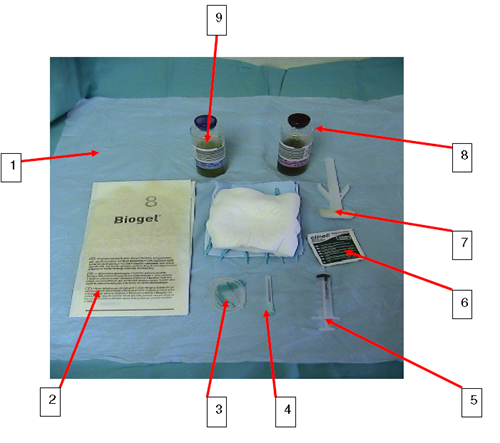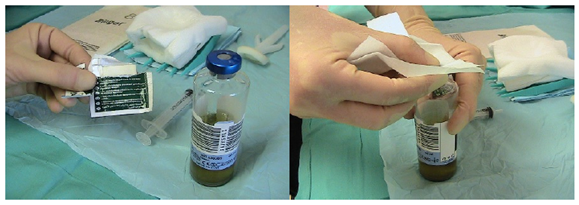Blood culture collection
exp date isn't null, but text field is
Objectives
The aim of this guideline is to improve the validity of blood culture results by standardising the collection of blood cultures in the paediatric intensive care unit.
Scope
This guideline should be followed by all healthcare professionals involved in obtaining blood cultures in the paediatric intensive care unit.
Audience
All medical and nursing staff involved in performing blood cultures (peripheral or central) should be aware of this guideline before performing the procedure. All medical and nursing staff should have seen the procedure prior to performing it themselves.
Blood cultures are used to detect bacteraemia in children and infants. The validity of results obtained is entirely dependent on specimen collection. Inaccuracies can lead to diagnostic and therapeutic difficulties. Contamination, or false positive blood cultures, can lead to inappropriate treatment, increased hospital stays and hospital, laboratory and pharmacy costs [1] [2]. Alternatively a false negative blood cultures can incorrectly exclude bacteraemia, leading to inadequate microbial coverage [3].
The following factors are important in obtaining blood cultures:
Site Collection
Although easier to achieve, Everts et al found that cultures from intravascular catheters were more likely to be contaminated than venepuncture cultures [4]. Therefore cultures should not be obtained from peripheral or arterial lines unless upon insertion. Initial culture sites should be peripheral whilst trying to avoid sites immediately above peripheral lines. Additional blood cultures should be taken from a central line if line sepsis is suspected or there are difficulties obtaining peripheral access [1]. In the case of suspected line sepsis, peripheral cultures should be taken first followed by central cultures.
Number & Timing of Cultures
It is important that blood cultures are taken before microbial therapy is commenced, though this should not delay commencing treatment. Collection of blood cultures in relation to fever spikes has not been found to increase yield [1]. The maximum yield for blood cultures is 30 minutes to 2 hours before the onset of fever. The number of blood cultures has been shown to increase the detection of bacteraemia [5]. However, too many unnecessary cultures can lead to false positives.
Site Preparation
Skin should be thoroughly disinfected before cultures are taken. ChloraPrep (combination of 2% chlorahexidine gluconate and 70% isopropyl alcohol) has been shown to be effective in cutaneous antisepsis and is supported by the epic2 guidelines for preventing healthcare associated infections in NHS hospitals [6].
Optimum Blood Volume
There is a relationship between the volume of blood and detection of organisms with the volume of blood being the most important variable in improving yield of organisms from blood cultures [3]. The optimum blood volume needed for blood cultures to maximize yield of organisms is uncertain. Although small volumes may be adequate in neonates, Connell et al suggest a minimum of 0.5-1ml for infants [3]. It is thought that the level of bacteraemia is higher in infants, therefore less volume is necessary to detect this, however some studies have shown that there may be low levels of bacteraemia in infants and small children that may not be detected by smaller blood volumes [3]. Obviously in small children, the amount of blood sampled for cultures needs to be considered in context to the size of the child, but larger volumes do have greater yields.
Aerobic vs Anaerobic Cultures
Paediatric anaerobic infections are unusual and most anaerobes will grow in an aerobic culture bottle [1]. If obtaining adequate volume is difficult, then blood should be put into the aerobic bottle, rather than splitting the volume between the two bottles. Certain clinical situations where investigation for anaerobic bacteraemia is important include febrile neutropenia, necrotizing infections of head, neck, skin and soft tissues, necrotizing pneumonia, brain abscess, gynaecological infections and infections following colorectal surgery. Children or infants in septic shock with no obvious focus should also have anaerobic blood cultures [1].
Other Considerations
Agents that require discussion with microbiologists as they require special preparation include Cryptococcus neoformans, legionella, mycoplasma, helicobacter, leptospira and fungal pathogens.

1. Dressing pack
2. Sterile gloves
3. Butterfly needle
4. 21G needle
5. Syringe
6. ChloraPrep swab
7. ChloraPrep 3ml applicator
8. Anaerobic blood culture bottle
9. Aerobic blood culture bottle
General approach described first followed by specific approach to taking peripheral and central blood cultures. Preparation of bottles also described.
|
Action |
Rationale |
|
Preparation Clean patient’s skin & identify suitable venepuncture site for peripheral cultures prior to procedure. If obtaining central cultures, identify appropriate line for culture. Central cultures are required for suspected central line sepsis or if unable to obtain peripheral cultures. Peripheral cultures should be performed before central blood cultures. Assemble equipment & prepare sterile field. Open all equipment onto the sterile field. Perform appropriate hand washing and put on sterile gloves. Preparation-peripheral culture Perform venepuncture distal of venous lines in same limb. Do not use existing peripheral lines. Squeeze wings of ChloraPrep 3ml applicator. Disinfect skin using back and forth strokes for 30sec. Allow 30-60s for Chloraprep to dry before proceeding with blood culture Preparation-central culture Clean hub of central line with Chloraprep swab & allow to dry for 30-60 seconds. Aspirate volume in central line lumen. Use separate syringe to aspirate blood for culture. Return discard to patient. Flush with 2ml of 0.9%NaCl Clean site with Chloraprep swab. Preparation of blood culture bottles Remove plastic cover from blood culture bottles & disinfect with Chloraprep swab for 30-60 seconds and allow to dry before bottle inoculation.
|
Avoiding skin contamination Avoid using central line lumens that are infusing drugs, especially inotropes, to avoid boluses. To reduce risk of introducing infection and contaminating blood culture bottles. Reduces risk of contamination. Peripheral cultures preferred. This allows solution to flow into the applicator. Ensures disinfection of skin. Do not palpate site again once disinfected, even when gloved, to avoid cross-contamination.
Allows microorganism killing Allows microorganism killing. Reduces risk of contamination of sample Allows microorganism killing Allows microorganism killing |
|
|
|
|
Do not change the needle on the syringe prior to inoculation of blood culture bottle. Fill blood culture bottles prior to other samples. Inoculate aerobic (blue) blood culture bottle before anaerobic (pink). Put the appropriate amount of blood in the blood culture bottle, depending on the weight of the child.
|
Reduces the risk of needlestick injury. Larger volumes of blood improve the yield of organisms from blood cultures but must be considered in relation to the weight of the child.
|
|
Correctly label the bottle with patient’s details, site of culture, weight & current antibiotic therapy. Document in case notes. Transfer immediately to incubator for collection (located in NNU, PICU & ED) |
Ensures appropriate information regarding samples are sent. It is important that blood cultures are stored appropriately.
|
|
Blood culture type |
Optimal Volume |
Minimal Volume |
|
Aerobic |
|
|
|
Weight |
|
|
|
<1kg |
0.5-1ml |
0.4ml |
|
1-3kg |
1ml |
0.5ml |
|
3-20kg |
3ml |
1ml |
|
20-35kg |
5-10ml |
5ml |
|
>35kg |
10ml |
5ml |
|
Anaerobic |
|
|
|
Weight |
|
|
|
1-10kg |
5ml |
3ml |
|
>10kg |
10ml |
5ml |
|
Other |
Fungal – see aerobic Mycobacteria – 3ml |
|
If inadequate volumes are obtained for both aerobic & anaerobic blood cultures, culture to be inoculated into the aerobic bottle.
1. British Columbia Children’s Hospital Blood Culture Collection Protocol. 2007.
2. BD Worldwide. http://www.carefusion.com/our-products/browse-brands/chloraprep
3. Connell TG, Rele M, Dowley D, Buttery J, Curtis N. How reliable is a negative blood culture result? Volume of blood submitted for culture in routine practice in a children’s hospital. Pediatrics 2007; 119(5): 891-6
4. Everts RJ, Vinson EN, Adholia PO, Barth Reller L. Contamination of catheter-drawn blood cultures. Journal of Clinical Microbiology 2001; 39(9): 3393-5
5. Cockerill FR, Wilson JW, Vetter EA et al. Optimal Testing Parameters for Blood Cultures. Clinical Infectious Diseases 2004; 28: 1724-30
6. Pratt RJ, Pellowe CM, Wilson JA, et al. Epic2: National evidence based guidelines for preventing healthcare-associated infections in NHS hospitals in England. Journal of Hospital Infection 2007; 65S: S1-64
Last reviewed: 01 February 2015
Next review: 01 February 2018
Author(s): C Harry, N Spenceley


